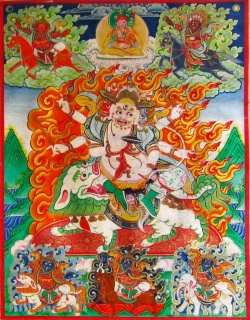Lamas of the Nechung Monastery
Biographical Summary of Nechung Kuten
Thupten Ngodrup was born on July 13, 1958, in Pari, Tibet. As a child he was artistically gifted, and had great compassion for others. In 1966, he and his family escaped Tibet by way of Bhutan to arrive in Dharamsala, India. In Dharamsala, he took ordination as a monk at Nechung Dorje Drayang Ling Monastery in 1970 at the age of 12. Nechung monastery is an institution that has been closely affiliated with the Tibetan Government and the succession of Dalai Lamas for centuries. It was just beginning to get reestablished, and Thupten Ngodrup was one of the first wave of new monks. Due to his qualities and artistic abilities, he quickly rose to the position of the Chief Ritual Assistant to the Nechung Protector while in trance. After the passing of Lobzang Jigme, the previous Medium in April 1984, there was a gap of three years when there was no presence of a Medium for the Nechung Oracle. The Nechung monks and the Tibetan community requested for the rapid appearance of a new Kuten in daily prayers. On March 31, 1987, the Venerable Thupten Ngodrup entered into his first spontaneous trance, during Drepung Monastery’s annual offering ceremony to the Protector at Nechung Monastery in Dharamsala. He displayed signs that he may indeed by the next Nechung Kuten.
His Holiness the Dalai Lama advised that he conduct an extended retreat and engage in special meditations and rituals and ripen and stabilize his abilities. On September 4, 1987, he was fully recognized to be the Medium of Nechung the Tibetan Oracle. The Nechung Kuten is an important figure for the Tibetan people and Tibetan Buddhism, and holds a position of great responsibility in the Tibetan government.
History of Nechung
Nechung Monastery's roots must be traced back several hundred years to understand its significance in Buddhist culture and Tibetan history. Dating back to the reign of King Trisong Detsen and the early dissemination of Buddhism in the 8th century, the Indian saint and tantric master Guru Padmasambhava appointed Pehar Gyalpo as the protector of Samye Monastery. At that time, Samye, Tibet's first monastery, was known as Nechen (the larger place). Nechung (Ne, place and chung, small) was a shrine dedicated to Pehar west of the capital of Lhasa, with a small monastic community of eight monks. Pehar was also bound to oath by Padmasambhava as head of the hierarchy of protectors for Tibet, with Dorje Drakden as his chief emissary.
When the Great Fifth Dalai Lama, Ngawang Lobsang Gyatso (1617-1682) gained temporal power in 1642; he instituted Pehar Gyalpo as the protector of the Tibetan government, thus Nechung Monastery became the seat of Tibet's State Oracle. The principal architect of Nechung Dorje Drayang Ling (in Tibet) was the Fifth Dalai Lama. It was on his advise and guidance that the "small place" was expanded during the regency of Desi Sangye Gyatso in 1681 and completed in 1683. The Great Fifth also composed Dra-Yang-Ma (Melodic Chant), a text of self-generation practice and an invocation of the protector, which was incorporated into the monastic rites. Other specialized prayers, rituals and training of many lineages were initiated into the monastery's practices and have been preserved until the present time.
Today, Nechung Monastery in occupied Tibet has about sixteen monks. Over sixty monks are being given the full training in these disciplines at the re-established monastery in India. Nechung Dorje Drayang Ling in Hawai'i is affiliated with this eminent tradition and is Nechung's headquarters in the West.
Nechung Monastery also struggled to maintain its' identity in exile. Only six of the 115 monks from the original monastery in Tibet had managed to flee in 1959, and Nechung Rinpoche, the head of the monastery, escaped in 1962. In order to be close to His Holiness the Dalai Lama, a small rented house in lower Dharamsala served as the monastery's temporary base, where novice monks were recruited and trained. After a few years, the Tibetan Government-In-Exile allotted Nechung Monastery a small plot of land directly below The Library on which a temple, a school,and monks' residences were built. Construction began in 1977 and was complete by 1984.
